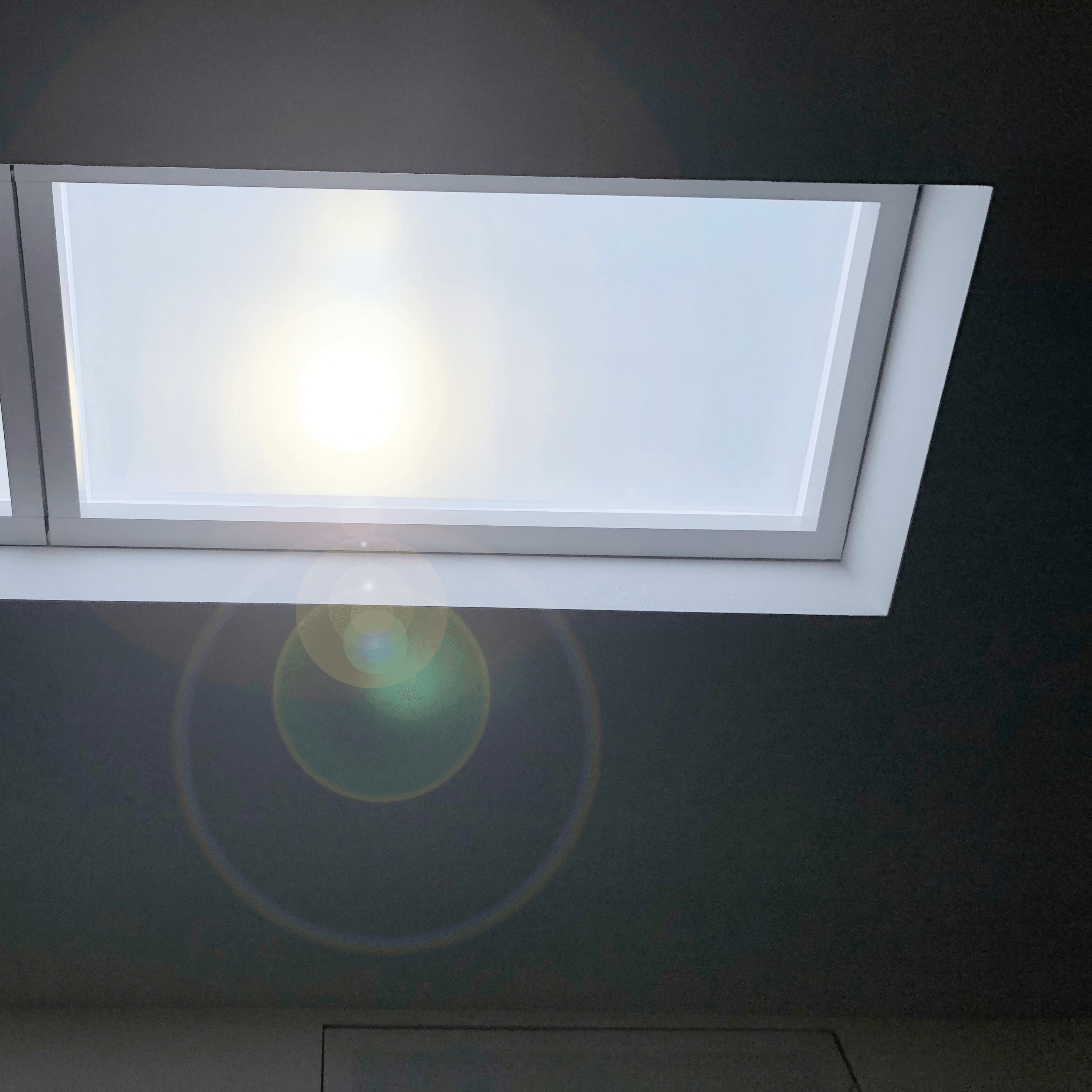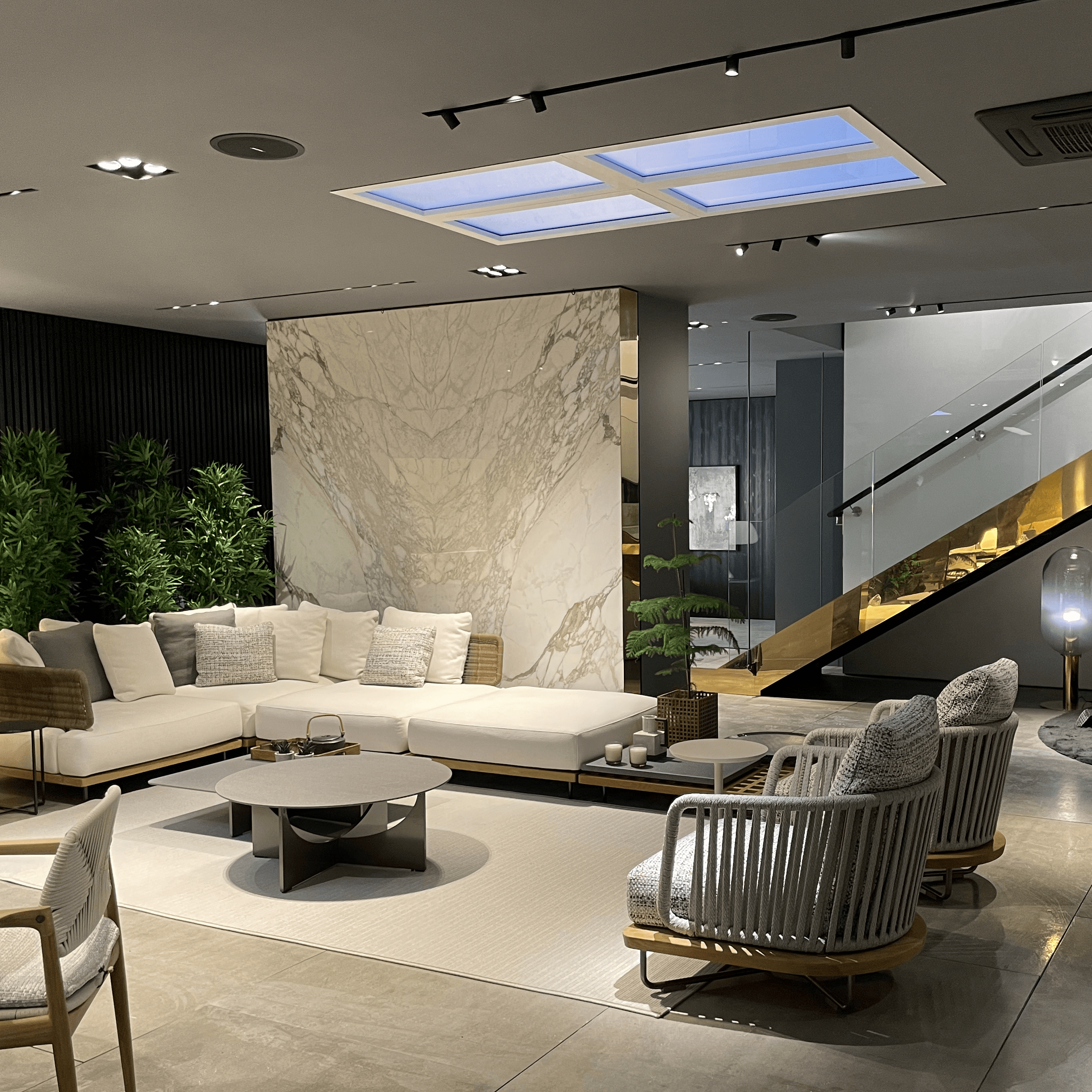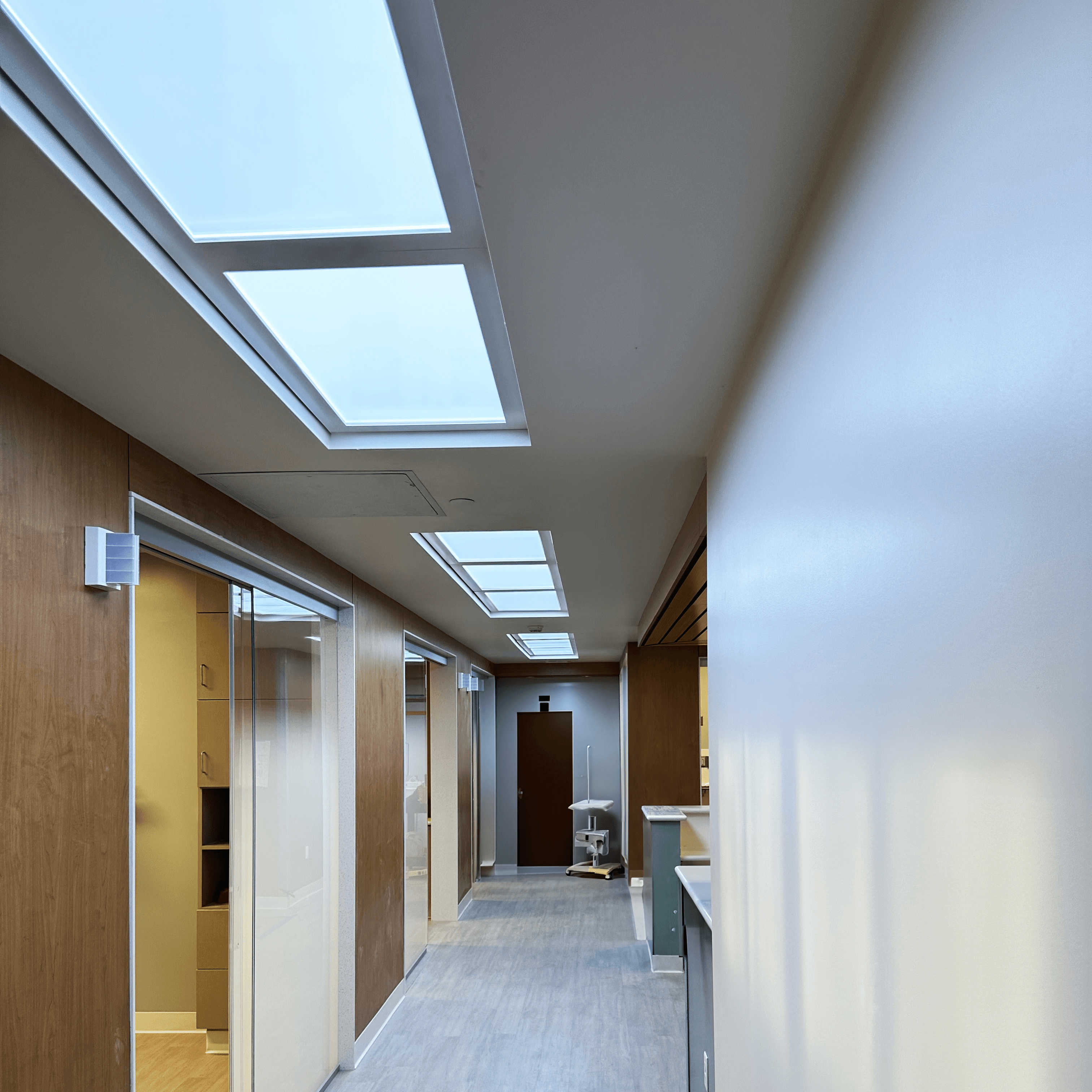Innerscene Health Impacts
Lighting plays a crucial role in our daily lives, affecting our circadian rhythms, sleep, mood, and overall well-being. Recent research has highlighted the importance of having both low and high equivalent melanopic lux (EML) , which simulates natural light to support these physiological processes. Innerscene's innovative lighting solutions, the Virtual Sun and Circadian Sky, have been designed to provide an adjustable and broad spectrum lighting that mimics natural daylight and supports the body's natural rhythms.
The Virtual Sun recreates the appearance of a skylight or window with a sun set at optical infinity, casting artificial sunlight into the room. With a CCT(Correlated Color Temperature) range of 3,200K to 40,000K and 0.5% dimming levels, it offers a wide range of lighting options.
The Circadian Sky provides the appearance of a sky with an even wider CCT range of 2,200K to 40,000K and comes in various architectural sizes. Both products have excellent photometrics, with a CRI greater than 90 and industry leading Melanopic Ratios, ensuring high-quality, natural-looking light that is designed with human health in mind.

One of the unique features of Innerscene's Virtual Sun and Circadian Sky is their ability to create the appearance of added depth to a room. By simulating the look of a skylight or window, these products can make a space feel more open and expansive, potentially leading to a greater sense of well-being and reduced feelings of confinement.
This added depth perception may be particularly beneficial in healthcare settings, where patients often spend extended periods in limited spaces, and in office environments, where employees may feel confined to their workstations.

For more information on the research supporting the importance of adjustable, high-quality lighting and its applications in various fields, please visit Innerscene's Research Center. The research center provides in-depth details on a wide range of topics, including the effects of light exposure on:
Health and well-being:Circadian rhythms, sleep, mental health disorders, cognitive function, and aging.
Medical applications:Patient recovery, pain management, cancer treatment, and various health conditions.
Productivity and performance:Alertness, employee satisfaction, education, and sports.
Specialized topics:Shift work, jet lag, phototherapy, and lighting design considerations.
Circadian Rhythms, Sleep, and Wellness

Recent research underscores the significant impact of lighting, particularly variations in melanopic lux (EML), on circadian rhythms, sleep quality, and overall well-being. Studies have shown that exposure to high correlated color temperature (CCT) light with high EML during the day can help regulate the body's internal clock, leading to improved sleep patterns and reduced sleep disturbances. Conversely, low EML lighting in the evening helps promote the natural production of melatonin, preparing the body for restful sleep ([Lockley et al., 2006]; [Cajochen et al., 2011]).
Innerscene’s Virtual Sun and Circadian Sky allow adjustments from warm, low EML to cool, high EML settings and can dim to very low levels, crucial for aligning environmental lighting with the body’s natural circadian rhythms.
Patient Recovery and Healing

In healthcare and hospital environments, the ability to adjust the melanopic content of the lighting over a broad spectrum is essential for supporting patient recovery and healing. Research has demonstrated that exposure to high CCT or EML lighting during the day can help regulate sleep-wake cycles, alleviates symptoms of depression, and improve overall mood in patients ([Benedetti et al., 2001]; [Walch et al., 2005]).
By utilizing Innerscene's Virtual Sun and Circadian Sky, which mimic natural daylight and deliver appropriate EML levels throughout the day, healthcare facilities can create a more supportive environment that promotes patient well-being and faster recovery times.
Employee Satisfaction and Retention

Providing a well-lit, comfortable work environment with appropriate variable melanopic levels for the occupants can significantly enhance employee satisfaction and retention. Research indicates that exposure to high EML lighting during the day boosts overall well-being, comfort, and mood, while lower EML lighting as we approach the end of the day supports a healthy transition to rest and relaxation ([Viola et al., 2008]).
Innerscene's Virtual Sun and Circadian Sky products replicate natural daylight and foster a connection to the outdoors while also offering adjustable lighting for various times of the day, or space usage, enhancing employee morale, job satisfaction, and reducing turnover rates.
Mood Regulation and Seasonal Affective Disorder (SAD)

Lighting plays a crucial role in regulating mood and emotional well-being, and the capability to provide the appropriate spectrum of light for the time of day is essential for creating a supportive environment. Studies have demonstrated that exposure to high EML lighting during the day can alleviate symptoms of depression, seasonal affective disorder (SAD), and other mood disorders, while low EML lighting in the evening promotes relaxation and a positive mood ([Glickman et al., 2006]; [Terman & Terman, 2005]).
Seasonal Affective Disorder (SAD) is a type of depression that typically occurs during specific seasons, most commonly during the winter months when there is less natural daylight. Research has shown that exposure to high EML lighting, particularly with a high CCT, can help alleviate symptoms of SAD.

In a study by [Glickman et al., 2006], patients with SAD were treated with blue-enriched light therapy using LED lights with a peak wavelength of 468 nm. The results showed that this high EML lighting was effective in reducing SAD symptoms, with patients experiencing improved mood and reduced depression scores.
Similarly, [Terman & Terman, 2005] conducted a comprehensive review of light therapy for SAD and found that high-intensity, high CCT light (5000K or higher) was most effective in treating SAD symptoms. They also noted that the timing of light exposure, particularly in the morning, was crucial for optimal results.
Innerscene's Virtual Sun and Circadian Sky products can provide the necessary high EML and high CCT lighting to help manage SAD symptoms. The Virtual Sun offers a CCT range of 3,200K to 40,000K, while the Circadian Sky provides a range of 2,200K to 40,000K, both encompassing the high CCT values found to be most effective in treating SAD.
At high CCTs, Innerscene outputs more than 2-4 times more light in the 468 nm spectrum than other light fixtures on the market, making it much more effective at reducing the impact of SAD. In the evenings, the CCT can automatically or manually adjust to low values allowing for very little blue light emission which enables the body to produce melatonin and prepare for sleep.
What does the Research Say?
Innerscene has categorized more than 1500 research publications related to blue light and Circadian Health. Below are a few select research studies not linked above that that we recommend.
High sensitivity of the human circadian melatonin rhythm to resetting by short wavelength light [Lockley, et al 2003]
This paper studies the impact of light wavelengths on the human circadian rhythm, particularly focusing on how different colors of light influence melatonin suppression and circadian phase shifts. The research reveals that exposure to 460 nm blue light results in a two-fold greater circadian phase delay and doubles the suppression of melatonin compared to 555 nm green light, under the same conditions of exposure. These findings are crucial because they highlight the peak sensitivity of the human circadian pacemaker to blue-shifted light, which is different from the peak sensitivity of the conventional three-cone visual photopic system that peaks around 555 nm. The study suggests that standard photopic lux, used to measure light intensity, may not be appropriate for assessing the effectiveness of light in resetting the human circadian clock. This information is particularly valuable for architects and designers in optimizing indoor lighting environments to support natural circadian rhythms, potentially improving sleep quality and overall well-being in artificially lit spaces.
Melanopic Lux is highly correlated with color temperature as shown below. To achieve the same level of Melanopic lux, 4 times as much photopic lux is required for 2,200k lighting compared to 40,000K lighting. This suggests that architects and designers should consider higher CCT lighting for day applications.

Recommendations for daytime, evening, and nighttime indoor light exposure to best support physiology, sleep, and wakefulness in healthy adults [Brown et al, 2022]
This publication provides expert recommendations for optimizing indoor light exposure across different times of the day to support healthy circadian rhythms, sleep, and alertness in adults. It introduces a new standard, the melanopic equivalent daylight illuminance (melanopic EDI), to measure light's effect on intrinsically photosensitive retinal ganglion cells, which are crucial for regulating these physiological responses. The guidelines suggest a minimum melanopic EDI of 250 lux during the day, a maximum of 10 lux in the evening, and below 1 lux at night to minimize disruption to the circadian system. These recommendations are based on a synthesis of extensive research, aiming to improve physical health and mental performance through better lighting environments. The findings stress the importance of adjusting light exposure not only for visual comfort but also for its non-visual effects on human biology.
By built-in automated control over CCT and dimming throughout the day, Innerscene can meet both the requirements for having high and low melanopic EDI. Innerscene makes this simple to implement, fixtures only need power connected when they arrive on site and they will automatically transition through night-day cycles. External dimmers and control systems can also be integrated to allow user control.

Illuminating wellness
Discover the Impact: Celebrating Exceptional Lighting Transformations
Office

Apple Campus - Cupertino
Boosting well-being and productivity at Apple Campus with Innerscene's lighting.
Commercial

Minotti Showroom - London
Minotti London’s display, lit by Innerscene’s Virtual Sun, melds Italian luxury with the brilliance of daylighting.
Healthcare

Cancer Center - Monterey
Monterey Comprehensive Cancer Center’s hallways glow with the soft, nurturing light of Virtual Sun units.

